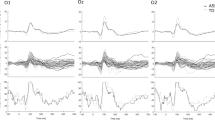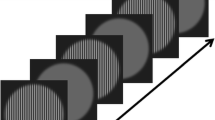Abstract
Purpose
Autism spectrum disorder (ASD) is a condition in which visual perception to both static and moving stimuli is altered. The aim of this study was to investigate the early cortical responses of subjects with ASD to simple patterns and moving radial rings using visual evoked potentials (VEPs).
Methods
Male ASD participants (n = 9) and typically developing (TD) individuals (n = 7) were matched for full, performance and verbal IQ (p > 0.263). VEPs were recorded to the pattern reversing checks of 50′ side length presented with Michelson contrasts of 98 and 10 % and to the onset of motion—either expansion or contraction of low-contrast concentric rings (33.3 % duty cycle at 10 % contrast).
Results
There were no significant differences between groups in the VEPs elicited by pattern reversal checkerboards of high (98 %) or low (10 %) contrast. The ASD group had a significantly larger N160 peak (1.85 x) amplitude to motion onset VEPs elicited by the expansion of radial rings (p = 0.001). No differences were evident in contraction VEP peak amplitudes nor in the latencies of the motion onset N160 peaks. There was no evidence of a response that could be associated with adaptation to the motion stimulus in the interstimulus interval following an expansion or contraction phase of the rings.
Conclusion
These data support a difference in processing of motion onset stimuli in this adult high-functioning ASD group compared to the TD group.

Similar content being viewed by others
References
Baird G, Simonoff E, Pickles A, Chandler S, Loucas T, Meldrum D, Charman T (2006) Prevalence of disorders of the autism spectrum in a population cohort of children in South Thames: the Special Needs and Autism Project (SNAP). The Lancet 9531:210–215
Baird G, Cass H, Slonims V (2003) Diagnosis of autism. BMJ 7413:488–493
St. Pourcain B, Wang K, Glessner JT, Golding J, Steer C, Ring SM, Skuse DH, Grant SFA, Hakonarson H, Davey Smith G (2010) Association between a high-risk autism locus on 5p14 and social communication spectrum phenotypes in the general population. Am J Psychiatry 11:1364–1372
Betancur C, Sakurai T, Buxbaum JD (2009) The emerging role of synaptic cell-adhesion pathways in the pathogenesis of autism spectrum disorders. Trends in Neurosci 7:402–412
Chakrabarti B, Dudbridge F, Kent L, Wheelwright S, Hill-Cawthorne G, Allison C, Banerjee-Basu S, Baron-Cohen S (2009) Genes related to sex steroids, neural growth, and social-emotional behavior are associated with autistic traits, empathy, and Asperger syndrome. Autism Res 3:157–177
Shukla DK, Keehn B, Müller RA (2010) Regional homogeneity of fMRI time series in autism spectrum disorders. Neurosci Lett 1:46–51
Casanova M, Trippe J (2009) Radial cytoarchitecture and patterns of cortical connectivity in autism. Philos Trans R Soc B 1522:1433–1436
Courchesne E, Redcay E, Morgan JT, Kennedy DP (2005) Autism at the beginning: microstructural and growth abnormalities underlying the cognitive and behavioral phenotype of autism. Dev Psychopathol 3:577–597
Villalobos ME, Mizuno A, Dahl BC, Kemmotsu N, Muller R (2005) Reduced functional connectivity between V1 and inferior frontal cortex associated with visuomotor performance in autism. NeuroImage 3:916–925
Happé F, Frith U (2006) The weak coherence account: detail-focused cognitive style in autism spectrum disorders. J Autism Dev Disord 1:5–25
Anderson JS, Nielsen JA, Froehlich AL, Du Bray MB, Druzgal TJ, Cariello AN, Cooperrider JR, Zielinski BA, Ravichandran C, Fletcher PT, Alexander AL, Bigler ED, Lange N, Lainhart JE (2011) Functional connectivity magnetic resonance imaging classification of autism. Brain 11:3742–3754
Happé FrithU (2009) The beautiful otherness of the autistic mind. Philos Trans R Soc B 1522:1345–1350
Milne E, Swettenham J, Hansen P, Campbell R, Jeffries H, Plaisted K (2002) High motion coherence thresholds in children with autism. J Child Psychol Psychiatry 2:255–263
Pellicano E, Gibson L, Maybery M, Durkin K, Badcock DR (2005) Abnormal global processing along the dorsal visual pathway in autism: a possible mechanism for weak visuospatial coherence? Neuropsychologia 7:1044–1053
Robert J, Keehn B, Connolly C, Wolfe JM, Horowitz TS (2009) Why is visual search superior in autism spectrum disorder? Dev Sci 6:1083–1096
O’Riordan M (2004) Superior visual search in adults with autism. Autism 3:229–248
O’Riordan M, Plaisted K, Driver J, Baron-Cohen S (2011) Superior visual search in autism. J Exp Psychol 3:719–730
Keehn B, Brenner L, Ramos A, Lincoln A, Marshall S, Müller R (2009) Brief report: eye-movement patterns during an embedded figures test in children with ASD. J Autism Dev Disord 2:383–387
Lee PS, Foss-Feig J, Henderson JG, Kenworthy LE, Gilotty L, Gaillard WD, Vaidya CJ (2007) Atypical neural substrates of embedded figures task performance in children with autism spectrum disorder. NeuroImage 1:184–193
Mottron L, Dawson M, Soulières I, Hubert B, Burack J (2006) Enhanced perceptual functioning in autism: an update, and eight principles of autistic perception. J Autism Dev Disord 1:27–43
Bonnel A, Mottron L, Peretz I, Trudel M, Gallun E, Bonnel A (2003) Enhanced pitch sensitivity in individuals with autism: a signal detection analysis. J Cogn Neurosci 2:226–235
Chakor H, Bertone A, McKerral M, Faubert J, Lachapelle P (2005) Visual evoked potentials and reaction time measurements to motion-reversal luminance- and texture-defined stimuli. Doc Ophthalmol 2:163–172
Bertone A, Mottron L, Jelenic P, Faubert J (2005) Enhanced and diminished visuo-spatial information processing in autism depends on stimulus complexity. Brain 10:2430–2441
Ashwin E, Ashwin C, Rhydderch D, Howells J, Baron-Cohen S (2008) Eagle-eyed visual acuity: an experimental investigation of enhanced perception in autism. Biol Psychiatry 65:17–21
Bach M, Dakin SC (2009) Regarding “eagle-eyed visual acuity: an experimental investigation of enhanced perception in autism. Biol Psychiatry 66:e19–e20
Tavassoli T, Keziah L, Bach M, Dakin SC, Baron-Cohen S (2011) Psychophysical measures of visual acuity in autism spectrum conditions. Vis Res 51:1778–1780
Bertone A, Mottron L, Jelenic P, Faubert J (2003) Motion perception in autism: a “complex” issue. J Cogn Neurosci 2:218–225
Del Viva MM, Igliozzi R, Tancredi R, Brizzolara D (2006) Spatial and motion integration in children with autism. Vis Res 8–9:1242–1252
Dakin S, Frith U (2005) Vagaries of visual perception in autism. Neuron 3:497–507
Simmons DR, Robertson AE, McKay LS, Toal E, McAleer P, Pollick FE (2009) Vision in autism spectrum disorders. Vis Res 22:2705–2739
Jones C, Swettenham J, Charman T, Marsden AJS, Tregay J, Baird G, Simonoff E, Happé F (2011) No evidence for a fundamental visual motion processing deficit in adolescents with autism spectrum disorders. Autism Res 5:347–357
Kuba M, Kubová Z, Kremlácek J, Langrová J (2007) Motion-onset VEPs: characteristics, methods, and diagnostic use. Vis Res 2:189–202
Kubová Z, Kuba M, Spekreijse H, Blakemore C (1995) Contrast dependence of motion-onset and pattern-reversal evoked potentials. Vis Res 2:197–205
Müller R, Gopfert E, Hartwig M (1985) Visual evoked potential studies on human cortical coding of the speed of movement of a grating pattern. EEG EMG Z Elektroenzephalogr Elektromyogr Verwandte Geb 2:75–80
Pitzalis S, Straqppini F, De Gasperis M, Bultrini A, Di Russo F (2012) Spatio-temporal brain mapping of motion onset VEPs combined with fMRI and retinotopic maps. PLoS ONE 7:e35771
Hoffmann MB, Bach M (1997) Motion onset VEPs: topographic distribution and dependence on stimulus velocity reveals two components. Brain Topogr 10:171
Lord C, Risi S, Lambrecht L, Cook EH, Leventhal BL, DiLavore PC, Pickles A, Rutter M (2000) The autism diagnostic observation schedule-generic: a standard measure of social and communication deficits associated with the spectrum of autism. J Autism Dev Disord 3:205–223
Baron-Cohen S, Wheelwright S, Skinner R, Martin J, Clubley E (2001) The autism-spectrum quotient (AQ): evidence from Asperger syndrome/high-functioning autism, males and females, scientists and mathematicians. J Autism Dev Disord 1:5–17
Kremláček J, Kuba M, Kubová Z, Chlubnová J (2004) Motion-onset VEPs to translating, radial, rotating and spiral stimuli. Doc Ophthalmol 2:169–175
Holm S (1970) A simple sequentially rejective multiple test procedure. Scand J Stat 6:65–70
Langrová J, Kuba M, Kremlácek J, Kubová Z, Vít F (2006) Motion-onset VEPs reflect long maturation and early aging of visual motion-processing system. Vis Res 4:536–544
Niedeggen M, Wist ER (1998) Motion evoked brain potentials parallel the consistency of coherent motion perception in humans. Neurosci Lett 2:61–64
Nakamura M, Kakigi R, Okusa T, Hoshiyama M, Watanabe K (2000) Effects of check size on pattern reversal visual evoked magnetic field and potential. Brain Res 872:77–86
Jemel B, Mimeault D, Saint-Amour D, Hosein A, Mottron L (2010) VEP contrast sensitivity responses reveal reduced functional segregation of mid and high filters of visual channels in Autism. J Vis 10:6
Bach M, Ullrich D (1994) Motion adaptation governs the shape of motion-evoked cortical potentials. Vis Res 12:1541–1547
Wist ER, Gross JD, Niedeggen M (1994) Motion aftereffects with random-dot chequerboard kinematograms: relation between psychophysical and VEP measures. Perception 10:1155–1162
McKay LS, Simmons DR, McAleer P, Marjoram D, Piggot J, Polick FE (2012) Do distinct atypical cortical networks process biological motion information in adults with autism spectrum disorders? NeuroImage 59:1524–1533
Koldewyn K, Whitney D, Rivera SM (2011) Neural correlates of coherent and biological motion perception in autism. Dev Sci 5:1075–1088
Tsermentseli S, O’Brien J, Spencer J (2008) Comparison of form and motion coherence processing in autistic spectrum disorders and dyslexia. J Autism Dev Disord 7:1201–1210
Milne E, White S, Campbell R, Swettenham J, Hansen P, Ramus F (2006) Motion and form coherence detection in autistic spectrum disorder: relationship to motor control and 2:4 digit ratio. J Auism Devp Disord 2:225–237
Chen Y, Norton DJ, McBain R, Gold J, Frazier JA, Coyle JT (2012) Enhanced local processing of dynamic visual information in autism: evidence from speed discrimination. Neuropsychologia 50:733–739
Vandenbroucke MWG, Scholte HS, van Engeland H, Lamme VAF, Kemner C (2008) Coherent versus component motion perception in autism spectrum disorder. J Autism Develop Disord 5:941–949
Kaiser MD, Shiffrar M (2009) The visual perception of motion by observers with autism spectrum disorders: a review and synthesis. Psychon Bull Rev 5:761–777
Neumann D, Spezio ML, Piven J, Adolphs R (2006) Looking you in the mouth: abnormal gaze in autism resulting from impaired top-down modulation of visual attention. Soc Cogn Affect Neurosci 3:194–202
Heinrich SP, Andrés M, Bach M (2007) Attention and visual texture segregation. J Vis 7(6):6
Fuller S, Liu T, Carrasco M (2006) Attention alters the appearance of motion coherence. J Vis 6
Acknowledgments
This work was funded by the College of Optometrists UK. The author (PAC) is a College of Optometrists Research Fellowship. Parts of this work were presented at ISCEV 2011, Quebec. We would thank the participants for their time whilst carrying out this study. We would like to thank Dr Alki Liasis and Dr Say Soriano for advice on MRI segmentation and field analysis. Thank you to the two anonymous reviewers for their helpful suggestions on this manuscript.
Conflict of interest
The author declares no conflict of interest.
Author information
Authors and Affiliations
Corresponding author
Rights and permissions
About this article
Cite this article
Constable, P.A., Gaigg, S.B., Bowler, D.M. et al. Motion and pattern cortical potentials in adults with high-functioning autism spectrum disorder. Doc Ophthalmol 125, 219–227 (2012). https://doi.org/10.1007/s10633-012-9349-7
Received:
Accepted:
Published:
Issue Date:
DOI: https://doi.org/10.1007/s10633-012-9349-7




